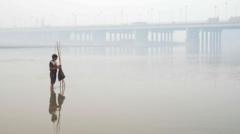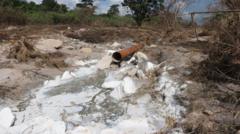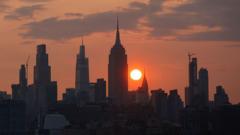Lahore’s air quality has plummeted, with the index soaring past 1,000, leading to school closures and health crises as officials scramble to respond to the worsening smog, primarily caused by traffic and agricultural burning.
Lahore's Dire Smog Situation Deepens as Health Crisis Unfolds

Lahore's Dire Smog Situation Deepens as Health Crisis Unfolds
Struggling against unprecedented air pollution levels, Lahore faces severe health impacts with declining air quality prompting emergency measures.
Lahore's air has taken a drastic turn for the worse, choking its 13 million residents under an oppressive blanket of smog. This environmental crisis has silenced the city, where people increasingly find it difficult to breathe without protective masks. Those who dare not wear them face immediate consequences as the acrid air irritates throats and causes coughing fits, disproportionately affecting children and the elderly. Local hospitals are bracing for a surge in patients suffering from respiratory issues, reflecting the significant public health risks posed by the polluted atmosphere.
This month, Lahore's air quality index has alarmingly surpassed the 1,000 mark multiple times—considered hazardous, as anything above 300 qualifies as dangerous. In response, Pakistani authorities have initiated emergency protocols, including closing schools, advising workers to remain home, and imposing a “green lockdown” restricting mobility in the most affected areas. By the week’s end, a court order required early closure of markets in Punjab, alongside the shuttering of parks and zoos until mid-November.
The sources of pollution are both complex and compounded by seasonal changes. According to NASA scientist Pawan Gupta, pollution levels are predicted to worsen leading into late November and December, currently exacerbated by rapidly dropping temperatures that trap pollutants close to the ground. Recent satellite imagery highlights the severity of the situation, displaying thick smog over Lahore along with numerous fires, which contribute significantly to the air quality crisis.
These fires are primarily lit by farmers from both Pakistan and India, burning stubble to clear their land for new crops. The practice is thought to account for about 30% of Lahore's smog, according to Pakistani environmental authorities. This year, NASA projects the detection of roughly 15,500 to 18,500 fires across the region, marking an increase from previous years. However, beyond agricultural fires, Lahore's dense vehicle traffic—particularly from its five million motorbikes—heavily contributes to the grim air quality.
Local reports have attributed a large portion of the smog to vehicular emissions, fueling ongoing concerns over the suffocating air enveloping the city. Meanwhile, various industries, including coal-fired brick kilns located on the outskirts, add to the toxic mix. These industrial pollutants fuse with cold air from Tibet, creating the smog that currently blankets Lahore.
Health officials report a sharp uptick in patients facing respiratory ailments, with Dr. Irfan Malik from a prominent hospital observing a notable increase in asthma and throat irritation cases. As distressing as this is, residents like Sadia Kashif express a heightened worry for their children's health amidst these conditions, lamenting the government’s short-term solutions that focus on school closures instead of addressing the underlying pollution crisis.
Efforts to mitigate the situation, such as spraying water to reduce airborne particulate matter, offer only temporary relief. Activists stress that the battle against air pollution in Lahore is not just seasonal—it requires sustained and systemic reforms, including improvements in public transport and stricter regulatory enforcement. In a gesture towards cooperation, Punjab Chief Minister Maryam Nawaz has signaled her intention to reach out to Indian officials to discuss collaborative environmental measures.
Experts are increasingly concerned over the city’s unprecedented pollution levels, stressing immediate action is crucial to prevent worsening public health crises. As Abid Omar points out, long-term strategies must be implemented urgently to ensure blue skies—the hallmarks of effective governance—return to Lahore.




















